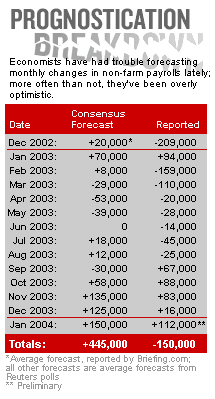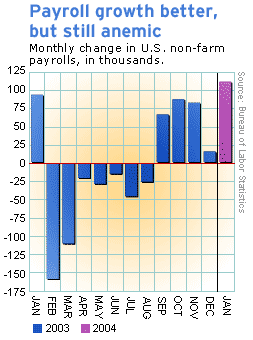NEW YORK (CNN/Money) - Though some economists hope Friday will bring blockbuster payroll growth figures, there are few signs the job market was much different in February than in January, when it was recovering but far from full strength.
On Friday, the Labor Department is scheduled to release its figures for February unemployment and non-farm payrolls growth. Economists, on average, expect that unemployment held steady at 5.6 percent and that payrolls grew by 125,000 jobs, according to Briefing.com.

Such job growth would be nothing to sneeze at. But the labor force grows by about 150,000 people a month, meaning that, even if economists' forecasts are accurate -- no sure thing, of course -- there would still be about 25,000 more people looking for work.
"It's not what we'd like to see," said Carl Tannenbaum, chief economist at LaSalle Bank/ABN Amro in Chicago, which expects 100,000 new jobs in February.
Twenty-seven months after the end of the last recession, payrolls are still 2.35 million jobs below where they were when the recession began, in March 2001, making this the longest job slump since the Labor Department started keeping track in 1939.
Technology-driven productivity gains have kept businesses from hiring in greater numbers, despite a robust economy in the second half of 2003.
| Related stories
|

|
|
|
|
But growth in productivity, a measure of output per worker hour, slowed in the fourth quarter, and past gains have helped businesses dramatically improve profits, which usually gives them a healthier appetite for new workers.
"Whether it's this month or the next handful of months, we see the combination of sustained productivity gains, profit growth and healthy increases in product demand leading businesses to want to rehire," said Mickey Levy, chief economist at Bank of America.
What's changed?
But many economists doubt that rehiring was robust in February, saying the standard job-market indicators weren't that different in February than they were in January, when just 112,000 new jobs were added.
For one thing, the number of new jobless claims during the week when the Labor Department takes its survey of households (to generate the unemployment figure) and businesses (to generate the payroll figure) was almost exactly the same in each month, as was the number of continuing claims -- people drawing benefits for more than one week.

The Fed's 'Beige Book' report of national economic activity in January and February said hiring grew "slowly" in each month and that employers were hit with "substantial increases" in health-care costs, another factor keeping firms reluctant to hire.
"That's not exactly an evaluation which would suggest that Friday's number will be a blowout to the upside," said Steve Stanley, economist at RBS Greenwich Capital Markets.
More ominously, several measures of consumer confidence worsened in February. The most reliable of those measures, the one compiled by the Conference Board, a private research firm, posted one of its biggest drops in recent history during the month, with a high percentage of consumers saying jobs were "hard to get."
"Confidence declines of this magnitude typically happen around 'shocks' or 'events,'" David Rosenberg, chief economist at Merrill Lynch, wrote in a recent research note. "We don't really know what the 'shock' was this time around, but maybe we'll find out when [the] non-farm [payroll report] is released on [Friday]."
All talk, little hiring
What have improved are the various surveys of business leaders and purchasing managers, typically considered good signs of future job growth.
Most notably, the employment indices in the Institute for Supply Management's monthly surveys of manufacturing and service-sector business activity have shown signs of job growth for several months.
But economists are divided about how much weight to give those measures, which show only the number of firms that are hiring, not how many people are being hired. If every firm in the ISM survey is hiring just a handful of workers, then the employment indices will look strong, but the total impact on payrolls may be minimal.
"The ISM reports are honestly not the best way to go about forecasting the payroll report," said Drew Matus, senior economist with Lehman Brothers.
Still other surveys, including the Business Roundtable CEO survey and the National Federation of Independent Business small-business-owner survey, also show an increasing appetite for new workers.
But those seem to contradict the anecdotal evidence compiled by Matus and some other economists.
Richard Yamarone, director of economic research at Argus Research in New York, said he has listened to 207 firms' earnings conference calls for the latest quarter and hasn't heard much to get excited about. For that reason, he expects payroll growth of just 45,000 in February, with a risk that the number could be even lower.
"I still don't think the tone has changed," Yamarone said. "I don't hear any hiring going on, and I don't hear any firings going on."
Of course, it's important to remember that economists have done a lousy job of predicting job growth lately; the consensus forecast for payroll growth has been overly optimistic in 9 out of the past 14 months.
The fact that so many economists are pessimistic about February job growth could mean they'll all be wrong on the downside on Friday -- or some other month in the future.
"It remains rational to expect [job] gains of over 200,000 per month in the upcoming months," said Anthony Crescenzi, bond market strategist at Miller Tabak & Co. "The longer it takes to reach that point the more likely it is that forecasters will continue to skedaddle and lower their forecasts still further."

|

